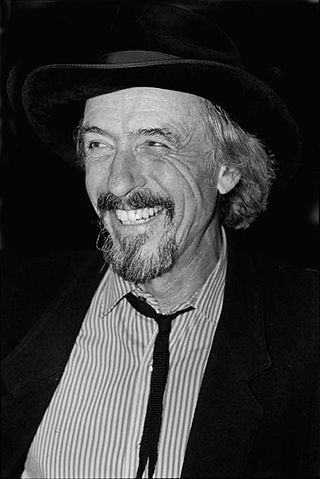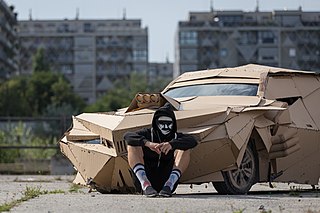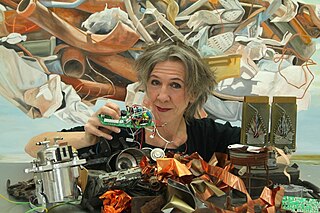Related Research Articles

The Museumsquartier (MQ) is a 90,000 m2 large area in the 7th district of the city of Vienna, Austria.

Arik Brauer was an Austrian painter, printmaker, poet, dancer, singer-songwriter, stage designer, architect, and academic teacher.

Mumok is a museum in the Museumsquartier in Vienna, Austria.

The Museum Of Young Art (MOYA) founded 2005 in Vienna, Austria, was the first museum worldwide exclusively devoted to 21st-century young art. The MOYA was privately owned, founded & owned by the Swiss and German art historian and art manager Dr. Kolja Kramer. It presented artworks produced exclusively after the year 2000 and focused especially on the early work of artists. The stylistic focus of its exhibitions was on contemporary painting, video installations, photography and Fantastic Realism. The museum provided opportunities for young artists to showcase their skills in a formal setting. However, in 2015 the MOYA-Museum of Young Art in Vienna was closed permanently.

The Künstlerhaus in Vienna's 1st district has accommodated the Künstlerhaus Vereinigung since 1868. It is located in the Ringstrassenzone in between Akademiestraße, Bösendorferstraße and Musikvereinsplatz.
Ludwig Merwart was an influential Austrian painter and graphic artist. He is an important representative of Tachism and was a major force in graphic arts and prints, especially after World War II. His work belongs to the most significant and interesting contributions to graphic arts in Austria to this day.

Erika Abels d'Albert (1896–1975) was an Austrian painter and graphic artist.

Erwin Puchinger was a Viennese painter, illustrator, industrial designer and graphic artist. He was an influential figure in Viennese art in the fin-de-siecle. Puchinger was a part of the Austrian Jugendstil and Gesamtkunstwerk movements, which sought to erase the boundaries between fine art and applied art. Puchinger worked in London, Prague and Paris as well as Vienna and collaborated with other major figures in Viennese art and design such as Ernst and Gustav Klimt and Otto Prutscher. He was a respected art professor at the Graphic Arts Institute, where he taught for more than thirty years. His work was also part of the painting event in the art competition at the 1936 Summer Olympics.

Renate Bertlmann is an Austrian feminist avant-garde visual artist, who since the early 1970s has worked on issues surrounding themes of sexuality, love, gender and eroticism within a social context, with her own body often serving as the artistic medium. Her diverse practice spans across painting, drawing, collage, photography, sculpture and performance, and actively confronts the social stereotypes assigned to masculine and feminine behaviours and relationships.
Markus Hofer is an Austrian sculptor. He is known for his creation sculptures which place everyday objects in unusual context.
Josefine Swoboda was an Austrian portrait painter. She was one of the most active Vienna portraitists.
Marcello Farabegoli is an Italian curator living in Vienna.
Hildegard Joos was an Austrian painter and is known as the "Grande Dame" of geometric abstraction and constructivism in Austria.
Leopold Fischer (1902-1978) was an Austrian police officer and much-awarded Pictorialist, and later, Modernist, photographer.

Jasmin Hagendorfer is a Vienna-based contemporary artist, writer, filmmaker, curator, producer and festival organizer. She is one of the founders and creative director of the Porn Film Festival Vienna. From 2019 to 2022 she was the creative director of Transition International Queer & Minorities Film Festival. Her main artistic interest is in installation, sculpture and performance, and her work has been exhibited in Austria, Germany, Turkey, Serbia and Greece. As an artist she is concerned with social and political discourses and questions about gender identity with an emphasis on post-porn political works. Her studio is based in Stockerau near Vienna.
Wang Xiaosong is a Chinese artist and professor. Having studied in Beijing and Berlin from 1983 to 1997, Wang uses a confluence of Chinese and Western art in his works.

Karin Mack is an Austrian post-war photo artist, who belongs to the avant-garde feminist art of the 1970s. She is known primarily for generating her themes from very personal introspection and then presenting them as if "in a theater of self-events".

Katharina Cibulka is an Austrian feminist artist, filmmaker and photographer whose work addresses gender-based inequity and power structures through public art projects such as her series of installations "SOLANGE". For her SOLANGE installations, Cibulka covers scaffolding at construction sites with monumental cross-stitch messages in bright pink tulle on white mesh fabric, following the pattern "As long as ... I will be a feminist." At least 27 SOLANGE installations have appeared in at least 21 cities, in countries including Austria, Slovenia, Morocco, Germany, and the United States. In 2021, Cibulka received the Tyrolean Prize for Contemporary Art from the State of Tyrol.

Golif is an Austrian Vienna-based artist. He is a representative of Austrian street and urban art.

Maria Temnitschka is an Austrian artist. At the beginning of her artistic career Maria Temnitschka designed and created jewellery and objects made of metal. Later she reoriented to painting - at first abstract, since 2000 figurative representation. Her preferred techniques are oil painting, drawing, experimental photography, object art.
References
- ↑ Szenegänger. In: Profil. August 24th, 2015; p. 88–89.
- ↑ "IG Kultur Wien: Innovationspreis .10" (in German). Retrieved 2018-08-06.
- ↑ Lorenz Seidler: Ein Esel erklärt die Kunst. In: Die Presse. (last accessed on February 15th, 2017)).
- ↑ Lorenz Seidler: Ein Esel erklärt die Kunst. In: Die Presse. (last accessed on February 15th, 2017).
- ↑ Michael Huber: Die Kunst, an Kunst teilzuhaben. (kurier.at [last accessed on February 15th, 2017]).
- ↑ eSeL.at | Blog Category: REZEPTION. Archived 2018-06-01 at the Wayback Machine (last accessed on February 15th, 2017 / in german).
- ↑ Brigitte Borchhardt-Birbaumer: eSeL bei Essl. Wiener Zeitung. May 5th, 2016 (last accessed on February 18th, 2017).
- ↑ eSeL.at | #MIY Festival Archived 2018-06-12 at the Wayback Machine . (last accessed on February 15th, 2017 / in german).